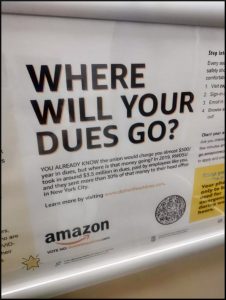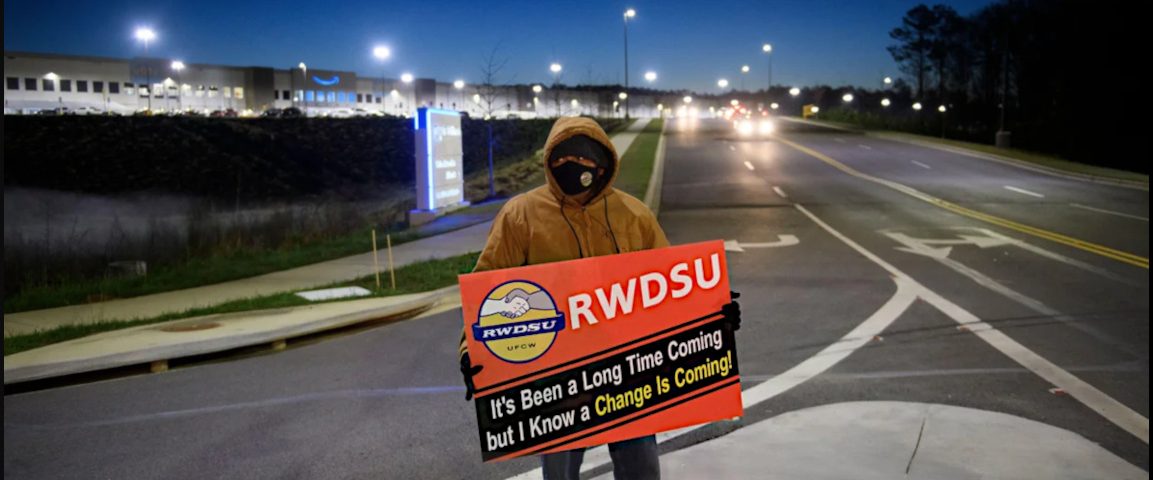By Mike Elk, published by Labor Today, April 9, 2021
Today, the union drive at Amazon in Alabama, which drew unprecedented political and media attention, was defeated by a 2-to-1 margin.
Last month, as we stood in the parking lot of Amazon’s warehouse and spoke with 32-year-old Ashley Beringer about her take on the Amazon union vote, it became apparent to us then why the union was headed for defeat.
“I guess I’m more so against it because I don’t know much about [unions], I’ve never had to deal with unions until now,” she said.
In our interviews with workers, we discovered most workers held similar views to Beringer. It wasn’t that they hated unions, who were heavily against them, but that they didn’t know much about unions and didn’t feel they could trust them.
In winning union elections, the election feels like more of a formality since the organizing committee has already been acting as a union, winning campaigns in the workplace to change things and standing up for co-workers facing unfair disciplining.
Then, when the union election comes, workers feel like they already know the union and are a part of it. In massive facilities with thousands of workers like Amazon, the process of building a strong organizing committee and building trust in the organizing committee through concerted action can sometimes take years.
RWDSU had only started its campaign last June when outrage over unsafe working conditions during COVID was raw. While they had an outpouring of initial momentum and interest, they never developed a strong organizing committee that took the time to build trust through shop-floor action and organizing against the boss.
Instead, they rushed a union election or did what is known in union organizing as “hot shopping,” where union organizers hope to take advantage of an outburst of anger in a facility over things such as poor COVID working conditions to force and win a quick union election.
However, their initial union enthusiasm support collapsed under the weight of a sophisticated anti-union campaign by Amazon that combined threats of job loss with promises of improvement if workers rejected the union. Many workers in interviews that voted against the union, admitted that they knew little about unions. This allowed the company through anti-union meetings to create fear over the change that unions could bring, warning workers that their wages may actually decrease under a contract or worse that their facility may close.
Not wanting to risk a relatively good job with the average wage of $16-an-hour, many workers chose the safety of the status quo rather than risk joining a union they didn’t know.
“I don’t want someone coming in and changing everything, especially if certain things are, you know, are good in the situation,” Beringer said. “And if [the union] comes in, I don’t know how it’s gonna be.”

While much of the labor press paints the captive audience meetings to be coercive, many workers we interviewed found the anti-union meeting run entirely by Black management consultants to be not so hostile.
“They were cool, they were just telling us what the union did,”
said 19-year-old Jeremiah Okai.
It was the presentation about union dues that helped persuade him to vote against the Amazon union in Alabama.
“[The union] is going to take money away from me,” Okai said. “I don’t want no money taken away from me.”
Indeed, many workers saw the meetings to be seen as a sign of management taking more of an interest in what workers were feeling at the plant. It’s a phenomenon known to HR managers as “The Hawthorne Effect” when people feel better about themselves knowing that they are being engaged by management.
“I think it’s harder for [workers] to move up in the companies,” 48-year-old pro-union Amazon worker Jennifer Bates told Payday Report in March. “So for them to even give them attention, makes them feel important.”
Even among workers, who had previously been members of RWDSU, support was flagging.
Ken Worth, 59, said that the mandatory anti-union meetings helped him reflect on his own negative experiences with the union.
“I’ve been a member of unions in the past and was actually a member of this same union,” Worth said. “I don’t really feel like they represented us well. I think that, you know, unions could do a whole lot more.”
Without a strong organizing committee already engaging the boss in shop-floor action, workers had no ability to see the potential upside of the union because they never got to see the union in action on the shop floor before being asked to vote on joining it.
While high-profile figures like President Joe Biden became involved to advocate on behalf of Amazon workers with an unprecedented video of support, his support came nearly five weeks into voting — too late to reverse all the negative effects of anti-union meetings for many workers as many workers had already voted.
Indeed, management regularly stood near the warehouse entrance and encouraged workers to take their ballot and drop it in a special postal box that they specifically installed directly outside of the plant gate while management watched. Amazon also created their sense of team pride, encouraging them to wear anti-union flair telling people to “Vote No.”
Walking by with a lanyard covered with “Vote No” pins, Danny Tavaris, 36, said that Amazon asked him to wear the pins at work to show their opposition to the union.
“I got this from Amazon, they’ve been giving them out,” anti-union Amazon worker Tavaris told us as he pointed to his lanyard full of “Vote No” pins. “Everybody has been wearing them.”
In contrast, the organizing committee was not able to build the same sense of team pride in the warehouse.
The weaknesses of the organizing committee’s approach were on full display on the last Friday of the campaign when a union rally headlined by Senator Bernie Sanders (I-VT) and rapper Killer Mike drew barely a dozen Amazon workers.
As a veteran labor reporter, I felt a distinct vibe that folks were too scared to show up to a rally like that. As is often the case following union defeat, many workers will likely face retaliation and many Amazon workers were likely too scared to show up.
RWDSU declined interview requests to discuss their organizing committee efforts or how much money they spent on the campaign.
While it would be too easy to label what happened at Amazon as a “defeat” in many ways it inspired a national movement. Within 24 hours of the defeat of the union at Amazon appearing likely, non-union workers at Amazon went on a wildcat strike in Chicago.
“I’m done with just accepting what the company does. I know my heart is telling me to take action. I’m willing to lead and be that example,”
Rakyle Johnson, a sorter, told the Chicago Sun-Times.
Organizers say this type of non-union wildcat strike in Chicago is exactly what’s needed to build support and trust in a union before an election. Activists were enthusiastic, though, that the Amazon campaign, which got unprecedented national as well as international media coverage, could create an appetite for more organizing on behalf of Amazon workers taking actions across the country.
Solidarity Actions with Amazon workers were held in over 50 cities across the U.S. with many groups plotting on how they could begin targeting the e-commerce behemoth in their own backyards.
Groups like Southern Worker Assembly, which helped organize the solidarity action, saw their membership swell as a result of interest in supporting Amazon workers in Alabama
“Whether the Amazon workers were conscious of it or not, it really drew attention to the need to organize, and the possibilities of really organizing in itself,”
said Saladin Muhammad, a retired veteran UE organizer and one of the founders of the Southern Worker Assembly.
“It drew attention to the fact that forces all over the country are eager to see the South being organized and are ready to engage in solidarity actions.”
Muhammad said that one of the flaws of the RWDSU’s approach was that they did not try to build a national movement and work with other unions to try to target multiple Amazon facilities across the country at the same time.
“Workers got to feel that they are part of the movement, not just part of a particular campaign that are sometimes defined by when you file for a union election and petition for a vote then you vote,” he said. “Sometimes people measure a struggle, a union campaign as the beginning and end of a struggle when this is a much larger battle of workers for power going on out in the world.”
While Muhammad is disappointed in the results, he believes that solidarity actions and support for Amazon workers could lay the infrastructure for the type of truly national movement. He says now is the time to dig and continue to build on the network of support built for Amazon workers during the union election.
“It’s an unfortunate ‘union vote’, ” emphasizes Muhammad. “But the defeat you understand would be if the factors that the fight developed: the solidarity network, the political positions of some the elected officials, the engagement of community organizations atrophied. The defeat would be if all that goes by the wayside.”
*Featured Image: A union supporter stands outside the Amazon fulfillment center in Bessemer, Alabama. | Photo: Patrick T. Fallon/Getty Images
